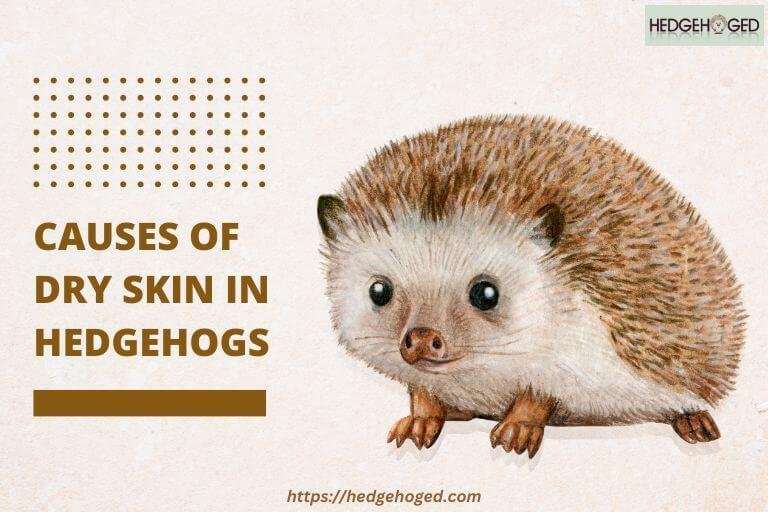Hedgehogs are intriguing and delightful creatures known for their unique spiky exterior and endearing appearance. However, like all other animals, they are susceptible to health issues, including Hedgehog dry skin. Dry skin in hedgehogs can be uncomfortable for them and can cause alarm to caregivers.
Below, we look at the causes of hedgehog dry skin in hedgehogs and common treatments and solutions that will ensure your spiky companion remains comfortable and healthy.
Dry Skin in Hedgehogs:
Hedgehogs Dry skin, also known as xerosis, is a condition that occurs when the natural moisture balance of the skin is disrupted, leading to various uncomfortable systems. While this condition is more prevalent in humans, hedgehogs can be victims even with their unique physiology.
Hedgehog dry skin manifests in humans with flaky and parched skin prone to itchiness. Your hedgehog may start shedding tiny dry flakes from their skin and quill, and this may cause their skin to appear reddish.
Causes of Dry Skin in Hedgehogs:
If you have noticed signs of dry skin on your hedgehog, here are some common issues that can contribute to the situation.
· Low Humidity:
Hedgehogs thrive best in areas with moderate to high humidity levels. However, hedgehogs may find it challenging when kept in indoor enclosures as pets since the humidity levels are usually not optimum.
The indoor air in most households tends to be drier than the outdoor environments they are used to. This difference in moisture can lead to a gradual loss of moisture from the skin, causing discomfort and dryness.
· Inadequate Diet:
Diet is a fundamental component in the overall health and well-being of hedgehogs. An imbalanced or inadequate diet can lead to many problems, including flakiness and dryness. With hedgehogs primarily insectivores, their diet is mainly invertebrates and insects.
An imbalanced diet means a lack of crucial nutrients like minerals and vitamins essential for skin health. Inadequate hydration can also exacerbate the issue of Hedgehog dry skin in hedgehogs.
· Environmental Factors:
Like many small mammals, hedgehogs are sensitive to environmental conditions, so maintaining the right temperature and humidity levels is essential. Extreme heat causes dehydration in hedgehogs, affecting their skin even further. Hedgehogs lose moisture through evaporation and perspiration in hot environments, which irritates their skin.
Likewise, extremely low temperatures reduce blood flow on the skin’s surface, making it more prone to damage and dryness. And since cold air is usually drier, it contributes to skin dryness. Drafty conditions also sap moisture from the skin, leading to potential discomfort.
Treating Hedgehog Dry Skin:
If you suspect your hedgehog has dry skin, it is essential to address the issue promptly. Here are steps you can take to alleviate Hedgehog dry skin and promote skin health:
-
Adjust Humidity Levels:
Adjusting the humidity levels in your hedgehog’s enclosure will help prevent and address Hedgehog dry skin issues. The ideal humidity level for hedgehogs to thrive is 40% to 60%, so ensure you maintain humidity within this range. You can use a hygrometer to measure the relative humidity.
-
Proper Diet:
A well-balanced and nutritious diet is critical for your hedgehog’s overall health, including maintaining healthy skin. It is advisable to seek guidance from a veterinarian to help you devise a feeding plan for your pet. They will offer recommendations tailored to the dietary needs of your hedgehog, factoring in its age, activity level, and overall health.
-
Strict Hygiene:
Occasional baths are beneficial in maintaining the skin health of your hedgehog. This will serve a dual purpose by helping to remove dead skin cells and providing much-needed hydration to their skin. Ensure you prioritize using the proper bathing techniques with effectiveness and comfort.
Once done, apply a fragrance-free moisturizer like olive oil to your pet’s skin. Avoid products with fragrances since they might irritate your hedgehog’s skin.
Final Thoughts:
Hedgehog dry skin is a common issue affecting these beloved spiky creatures. You can alleviate these problems by maintaining the proper environmental conditions, providing a balanced diet, and monitoring their health.


